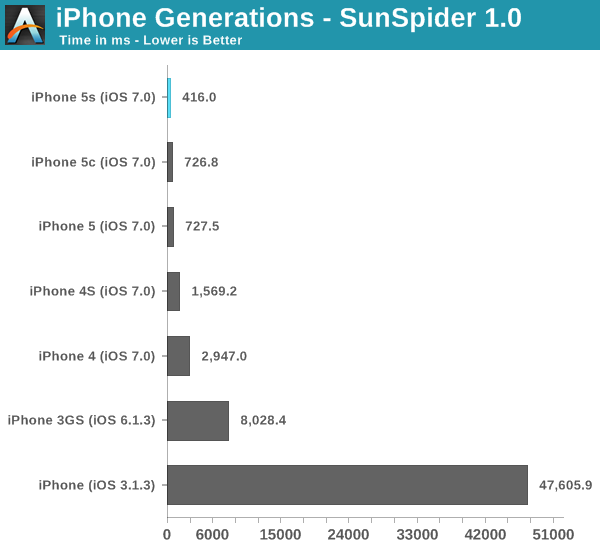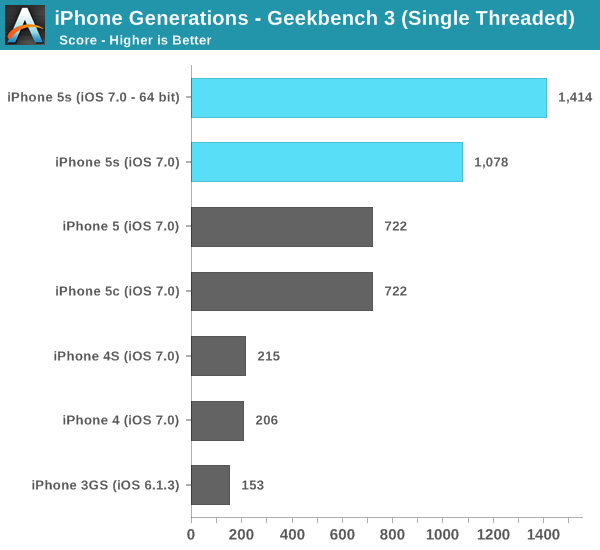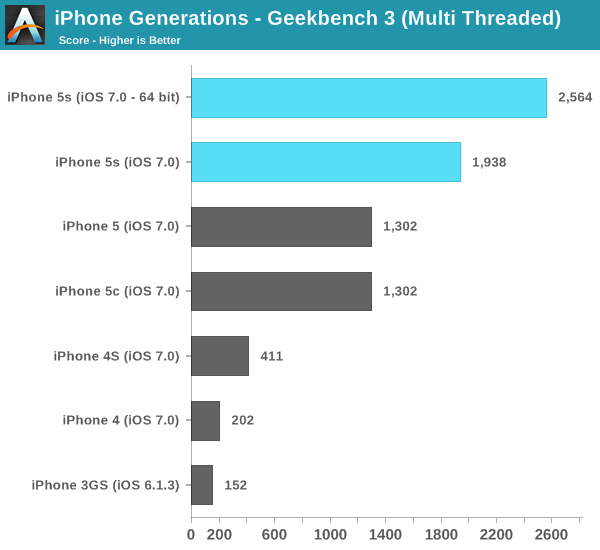The iPhone 5s Review
by Anand Lal Shimpi on September 17, 2013 9:01 PM EST- Posted in
- Smartphones
- Apple
- Mobile
- iPhone
- iPhone 5S
iPhone Performance Across Generations

Performance improved by a factor of 100x compared to the original iPhone. You can cut that in half if the iPhone could run iOS 4. Needless to say, Apple's CPU performance estimates aren't unreasonable. We've come a long way since the days when ARM11 cores were good enough.
Even compared to a relatively modern phone like the iPhone 4, the jump to a 5s is huge. The gap isn't quite at the level of an order of magnitude, but it's quickly approaching it. Using the single core iPhone 4 under iOS 7 just feels incredibly slow. Starting with the 4S things get a lot better, but I'd say the iPhone 4 is at the point now where it's starting to feel too slow even for normal consumers (at least with iOS 7 installed).

Browsermark 2.0 gives us a good indication of less CPU bound performance gains. Here we see over a 5x increase in performance compared to the original iPhone, and an 83% increase compared to the iPhone 4.
I wanted to have a closer look at raw CPU performance so I turned to Geekbench 3. Unfortunately Geekbench 3 won't run on anything older than iOS 6, so the original iPhone bows out of this test.

Single threaded performance scaled by roughly 9x from the 3GS to the iPhone 5s. The improvement since the iPhone 4/4S days is around 6.5x. Single threaded performance often influences snappiness and UI speed/feel, so it's definitely an important vector to scale across.

Take into account multithreaded performance and the increase over the 3GS is even bigger, almost 17x now.
The only 3D test I could get to reliably run across all of the platforms (outside the original iPhone) was Basemark X. Again I had issues getting Basemark X running in offscreen mode on iOS 7 so all of the tests here are run at each device's native resolution. In the case of the 3GS to 4 transition, that means a performance regression as the 3GS had a much lower display resolution to deal with.

Apple has scaled GPU performance pretty much in line with CPU performance over the years. The 5s scores 15x the frame rate of the iPhone 4, at a higher resolution too.
iPhone 5s vs. Bay Trail
I couldn't help but run Intel's current favorite mobile benchmark on the iPhone 5s. WebXPRT by Principled Technologies is a collection of browser based benchmarks that use HTML5 and js to simulate a number of workloads (photo editing, face detection, stocks dashboard and offline notes).

Granted we're comparing across platforms/browsers here, but the 5s as a platform does extremely well in Intel's favorite benchmark. The 5c by comparison performs a lot more like what we'd expect from a smartphone platform. The iPhone 5s is in a league of its own here. While I don't expect performance equalling the Atom Z3770 across the board, the fact that Apple is getting this close (with two fewer cores at that) is a testament to the work done in Cupertino.
At its launch event Apple claimed the A7 offered desktop class CPU performance. If it really is performance competitive with Bay Trail, I think that statement is a fair one to make. We're not talking about Haswell or even Ivy Bridge levels of desktop performance, but rather something close to mobile Core 2 Duo class. I've broken down the subtests in the table below:
| WebXPRT Performance (time in ms, lower is better) | ||||||
| Chrome/Mobile Safari | Photo Effects | Face Detection | Stocks | Offline Notes | ||
| Apple iPhone 5s (Apple A7 1.3GHz) | 878.9 ms | 1831.4 ms | 436.1 ms | 604.6 ms | ||
| Intel Bay Trail FFRD (Atom Z3770 1.46GHz) | 693.5 ms | 1557.0 ms | 542.9 ms | 737.3 ms | ||
| AMD A4-5000 (1.5GHz) | 411.2 ms | 2349.5 ms | 719.1 ms | 880.7 ms | ||
| Apple iPhone 5c (Apple A6 1.3GHz) | 1987.6 ms | 4119.6 ms | 763.6 ms | 1747.6 ms | ||
It's not a clean sweep for the iPhone 5s, but keep in mind that we are comparing to the best AMD and Intel have to offer in this space. I suspect part of why this is close is because both of those companies have been holding back a bit (there's no rush to build the fastest low margin parts), but it doesn't change reality.










464 Comments
View All Comments
solipsism - Friday, September 20, 2013 - link
Across different browsers and/or OSes it's not when comparing the same OS and same browser on that OS the tests can be use to gauge HW improvements, as shown with the iOS7 and Safari on the iPhone 5 v. iOS7 and Safari on the iPhone 5S.solipsism - Friday, September 20, 2013 - link
Overall you're reading too much into it. It's just to gauge how something nearly everyone uses on a daily basis may have improved YoY between devices and OS updates. You can't deny the results are much improved even if you don't think the tests in and of themselves are viable measures of the browser's overall performance.HisDivineOrder - Friday, September 20, 2013 - link
Reminds me of the 3GS or the iPad 2. Its CPU and GPU are far overpowered compared to the underlying requirements of the display provided. In this way, they are set up for a future, higher resolution, better display where a more minor leap will progress them forward into a new product number (ie., iPhone 6).I imagine it will last as long as the 3GS and iPad 2, too. Those who bought an iPad 2 got an impressive lifespan for their product. Too bad Apple looks to make the iPhone 5 and iPad 3rd gen go bust far more quickly or people might think Apple products had a good long lifespan.
Also, kinda sad that Android is still so far ahead of iOS in all the ways that really matter in the here and now.
systemsonchip4 - Saturday, September 21, 2013 - link
Android is only ahead in marketshare, because Android is cheap, not that its great. iOS has Android and its manufacturers beat in just about almost every metric(customer satisfaction rating, most durable products, most loyal user base, etc...)Abhip30 - Tuesday, September 24, 2013 - link
lol. Its like saying a corolla has more marketshare then a mercedes. :Pnedjinski - Friday, September 20, 2013 - link
and then there are the realities that nobody seems to care about -http://www.wired.com/opinion/2013/09/ifixit-teardo...
iannoisrk - Friday, September 20, 2013 - link
Question on the geekbenchmark. Was it 32 bit code running on 64 bit isa or 64 bit code running? Most apps will probably run 32 bit code. Wonder what the numbers will look like for them.ka27orl - Friday, September 20, 2013 - link
can you do a review on BB10 devices please, e.g. Z30. I heard it beaten all quad core android phones in browsermark and performance tests.Harry_Wild - Friday, September 20, 2013 - link
I was very tempted to get the 5S but I knew Apple would not go all out on the A7 chip from previous iPhones. And now I am proven right! It only has 1GB RAM.I will wait patiently for the iPhone 6 and re-evaluate the phone market in mid-summer! I really like the gold color too!
systemsonchip4 - Friday, September 20, 2013 - link
So the iPhone 5S has 2 Cortex ARM-A57 cores clocked at 1.3 ghz roughly ... Amazing, thats why its able to beat out the S800 SoC